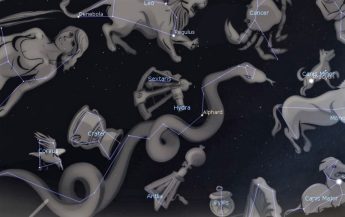This Week’s Sky at a Glance, 2024 Jan. 27 – Feb. 3
This Week’s Sky at a Glance, 2024 Jan. 27 – Feb. 3
The constellation Hydra is the largest of the 88 and it represents a female water snake. I mention the gender because there is a male water snake constellation, Hydrus, in the southern hemisphere. A small trapezoid of stars, located about halfway below a line between Procyon in Canis Minor and Regulus in Leo, represents the snake’s head. To its lower left is a solitary bright star called Alphard, the heart of the snake. The rest of the constellation is a long serpentine string of fainter stars that stretches to Virgo. It takes about eight hours for the entire constellation to rise. Two other constellations, Corvus the Crow and Crater the Cup, are sitting on Hydra’s back.
In mythology, Hercules had to kill the multiheaded Hydra as the second of his famous labours. Knowing the creature could only be killed by severing all of the heads, and that two would grow in where one was severed, he placed a tree stump in a fire. When he cut off a head he cauterized the wound with the glowing stump to prevent regrowth. When Hera saw that Hercules might win she sent a crab to distract him, but he easily stomped it dead. That explains the presence of the dim constellation Cancer the Crab just above the head of Hydra. Hera despised Hercules because he was the illegitimate son (one of many) of her husband Zeus. When the Hydra was slain, Hercules dipped his arrows in the Hydra’s poisonous blood for later use.
This Week in the Solar System
Saturday’s sunrise in Moncton is at 7:47 and sunset will occur at 5:16, giving 9 hours, 29 minutes of daylight (7:50 and 5:23 in Saint John). Next Saturday the Sun will rise at 7:39 and set at 5:26, giving 9 hours, 47 minutes of daylight (7:42 and 5:33 in Saint John).
The Moon passes near Spica in Virgo from Wednesday night to Thursday morning, and it is at third quarter phase on Friday. Saturn sets around 7:30 pm midweek, heading toward conjunction at the end of February. On Monday evening telescope users might see Jupiter’s moons Io and Europa disappear behind the planet at 6:57 and 8:29, respectively. Io reappears from Jupiter’s shadow at 10:28, while Europa emerges from occultation at 10:53 and gets eclipsed at 11:15. Mercury and Mars rise just two minutes apart and an hour before sunrise this Saturday morning, about a hand span lower left of Venus. You will need binoculars and a clear horizon, with dimmer Mars being a tougher target below Mercury.
On Sunday evening at 8 pm, tune in to the Sunday Night Astronomy Show via the Facebook page or YouTube channel of Astronomy by the Bay.

